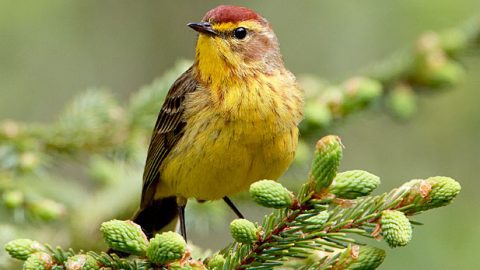North of the Treeline: The Hardy Lives of Arctic-Breeding Birds
By Grainger Hunt
From the Summer 2015 issue of Living Bird magazine.
Willow Ptarmigan by Dan Behm via Birdshare July 15, 2015North of 67 degrees latitude, trees exist only as shrubs, or not at all. The treeless region is the tundra, and it rings the Arctic Ocean from Alaska to Greenland, from Sweden to the Bering Sea. Where soils permit, tundra is a brave mix of dwarf shrubbery, lichens, mosses, grasses, and sedges, and despite the very short growing season, much of it is rich in nutrients, coming alive with the warmth and greening of round-the-clock summer sunlight. Each spring, an adventurous fraction of the planet’s birdlife journeys to this farthest northern land to raise its young. A hardy few species stay year-round and endure its long and unforgiving winter.
An Inextricable Link: Ptarmigan and Gyrfalcon
Ptarmigan are the avian substance of the open tundra, living there throughout the year with their principal predator, the Gyrfalcon. Ptarmigan are evolutionary experts at camouflage—white in winter snow, brown and black in summer, blending with the tundra as if bird and vegetation were of one fabric.
Each spring, an adventurous fraction of the planet’s birdlife journeys to this farthest northern land to raise its young.
The powerful Gyrfalcon, for whom these deceits are intended, may be white as well, or the gray of Arctic shadow and winter sky. Gyrfalcons and ptarmigan are bound together by a web of nourishment that arises from the seeds and berries, buds and catkins, of tundra vegetation. Range maps show Rock Ptarmigan and Gyrfalcons extending to the very northernmost extremes of the earth’s landmasses: Ellesmere Island, in Canada’s far northern Nunavut territory, and to the far side of Greenland, beyond 80 degrees north latitude. Climate graphs for these regions portray a frigid, windy desert, with only a few months of anything approaching human habitability.
The truth is that both Rock Ptarmigan and Gyrfalcons leave these highest latitudes during the coldest and darkest period— usually not going far, but far enough to escape the worst of it and still be in open terrain. They return to Ellesmere Island in spring, when the days are beginning to show a fair amount of sun, yet long before the summer green. Gyrfalcons lay their eggs in April and incubate them in May. Even then, daytime temperatures almost never climb above freezing. It’s all done on the promise of near-perpetual daylight in June and July, which will warm the tundra, creating an explosive bloom of life, sustaining everything from insects to musk oxen.
Gyrfalcons do not build nests. In the open tundra they rely on cliff ledges, especially those with sheltering overhangs. There is fierce competition for these sites, not only with other Gyrfalcons, but with Peregrine Falcons and Golden Eagles as well. Gyrfalcons are highly territorial, and their eyries are miles apart.
When breeding begins, ptarmigan are the only available food aside from adult Arctic hares, although the latter are so large that Gyrfalcons may risk injury in subduing them. And ptarmigan aren’t a sure catch either. For one thing, their populations are unreliable, exhibiting huge fluctuations over much of their tundra range, such that hundreds of ptarmigan in one year may be reduced to dozens the next. Population cycles of ptarmigan often span 9 to 11 years, and Gyrfalcons may forego nesting altogether in years when ptarmigan are few.
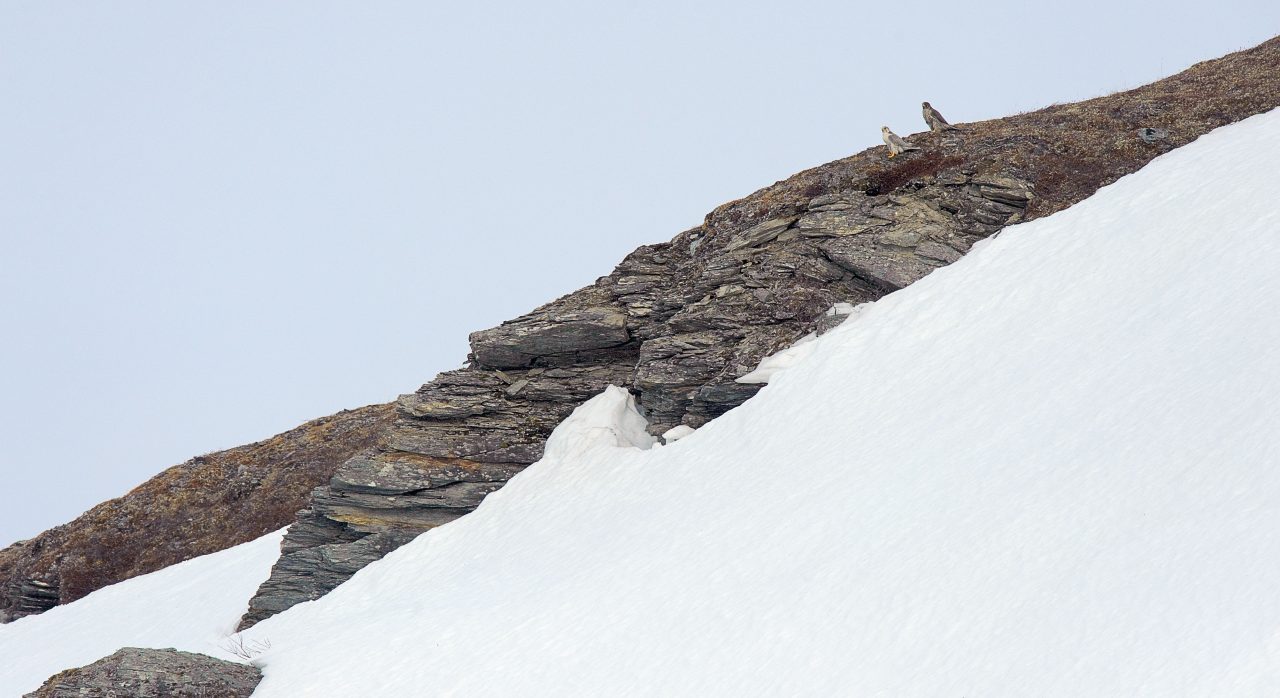
Seasonal Visitors: the Lapland Longspur and Northern Wheatear
Two tundra nesters that winter far away are the Lapland Longspur and the Northern Wheatear. One is a seedeater and the other an insectivore, and neither weighs much more than an ounce.
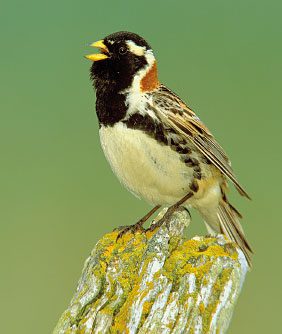
Longspurs and wheatears arrive in May and June, breed in a hurry, and make a quick getaway. The former spend the winter in the plains of the continental United States, but wheatears travel to sub-Saharan Africa, an astoundingly long distance away. A little three-quarter-ounce wheatear on Ellesmere Island crosses the North Atlantic nonstop in 30 hours, moves south through Western Europe, then braves the vast desert region of North Africa to reach the subtropical grasslands in September or October. Some even go directly there, traveling 2,200 miles straight across the Atlantic to Nigeria, the longest overwater migration of any songbird.
Perhaps even more amazing, wheatears that nest in northwestern Canada and Alaska also winter in African grasslands, but they take a different route. Some travel more than 9,000 miles across Siberia and the rest of Eurasia to arrive in eastern Africa. Young wheatears begin their epic journeys just a month or so after learning to fly! They possess all the sophisticated genetic programming they need to complete a passage from the far end of North America to Africa and back. The necessary instructions are included with all the other genetic code that orchestrates the life of a wheatear—everything efficiently packaged in that tiny brain.
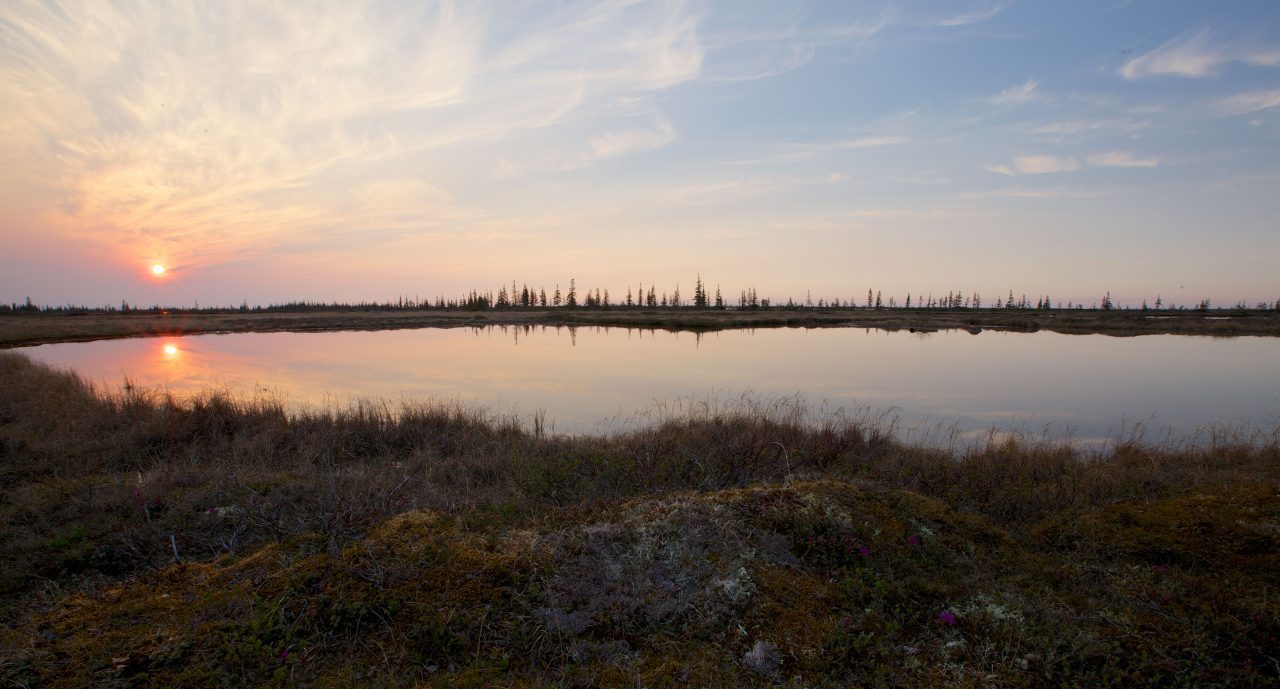
Tough Little Birds: Snow Buntings and Redpolls
Snow Buntings, like wheatears, are resolute in their approach to life. The males reach the High Arctic in April, when it is still well below freezing, and the only things to eat are seed spikes that have been stripped of snow by spring storms. Snow Buntings nest in rock crevices, and the males arrive early and compete with each other to find and defend the best nest sites. Females come three or four weeks later and place their nests in crannies a foot or so deep within the cold rock, presumably to escape heat-stealing winds and the notice of weasels. A female Snow Bunting may remain within her stony recess throughout the incubation period, fed entirely by the male, whose husbandly fortitude can only be imagined. These birds are apparently so tough that when it’s stormy, they may hunker down on the leeward sides of drifts, allowing snow to nearly envelop them.
How is it that these creatures have such a commitment to toughing it out, when they could just leave?
Why do Snow Buntings submit to such fierce conditions? Why don’t the males just delay their arrival? The answer may lie in those rocky slots they need for nesting and the fact that such accommodations vary in quality—their nearness to food and safety from predators. The genes of the male Snow Buntings that obtain the best spots increase in the population at the expense of the others, an evolutionary process that keeps the competitive edge of male Snow Buntings sharp.
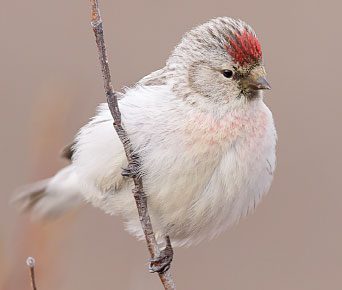
No one would question the remarkable grit of migrating wheatears or early-arriving Snow Buntings, but consider the alternative of staying put, of spending the entire winter on the tundra. Consider the Hoary Redpoll. How does a tiny seedeater like this, with so small a metabolic engine, survive at minus 30 or 40 degrees Fahrenheit, when the Arctic wind is raging and darkness or dim twilight reigns for months on end. They do have an extraordinarily thick downy insulation and an ability to accumulate great volumes of seeds in their crops. Still…
The High Arctic winter is not to be taken lightly. It is cold, dark, dry, windy, and long lasting. And yet its creatures find it workable—the crafty Snowy Owl listening for lemmings beneath the snow; the speedy Gyrfalcon chasing a ptarmigan in the dim Arctic twilight; the amorous male Snow Bunting, whose belle has arrived in an ice storm. How is it that these creatures have such a commitment to toughing it out, when they could just leave?
But I suspect that a redpoll would be miserable in Florida, and a Rock Ptarmigan alarmingly out of its element almost anywhere people find cozy and comfortable. Squatting in a snowdrift, just inches from the frigid, howling wind of a Greenland spring storm, would ruin a Field Sparrow’s day and be entirely unremarkable for a Snow Bunting. The fact is that these creatures, like all others, are at home where they evolved.

All About Birds
is a free resource
Available for everyone,
funded by donors like you
American Kestrel by Blair Dudeck / Macaulay Library
